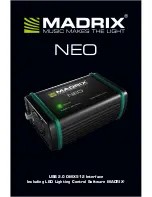
Owner’s Manual Play Set
Rev10/14/13
APPENDIX A
Information on Playground Surfacing Materials:
The following information is from the
United States Consumer Product Safety Commission’s Information
Sheet for playground surfacing material;
also see the following website for additional information:
www.cpsc.gov/cpscpub/pubs/323.html
.
X3. SECTION 4 OF THE CONSUMER PRODUCT SAFETY COMMISSION’S OUTDOOR HOME PLAYGROUND SAFETY
HANDBOOK
9
X3.1 Select Protective Surfacing—One of the most important things you can do to reduce the likelihood of serious head
injuries is to install shock-absorbing protective surfacing under and around your play equipment. The protective surfacing should be
applied to a depth that is suitable for the equipment height in accordance with ASTM Specification
F 1292
. There are different types of
surfacing to choose from; whichever product you select, follow these guidelines:
X3.1.1 Loose-Fill Materials:
X3.1.1.1 Maintain a minimum depth of 9 inches of loose-fill materials such as wood mulch/chips, engineered wood fiber
(EWF), or shredded/recycled rubber mulch for equipment up to 8 feet high; and 9 inches of sand or pea gravel for equipment up to 5
feet high. NOTE: An initial fill level of 12 inches will compress to about a 9-inch depth of surfacing overtime. The surfacing will also
compact, displace, and settle, and should be periodically refilled to maintain at least a 9-inch depth.
X3.1.2 Use a minimum of 6 inches of protective surfacing for play equipment less than 4 feet in height. If maintained properly,
this should be adequate. (At depths less than 6 inches, the protective material is too easily displaced or compacted.) NOTE: Do not
install home playground equipment over concrete, asphalt, or any other hard surface. A fall onto a hard surface can result in serious
injury to the equipment user. Grass and dirt are not considered protective surfacing because wear and environmental factors can
reduce their shock absorbing effectiveness. Carpeting and thin mats are generally not adequate protective surfacing. Ground level
equipment such as a sandbox, activity wall, playhouse or other equipment that has no elevated play surface – does not need any
protective surfacing.
X3.1.3 Use containment, such as digging out around the perimeter and/or lining the perimeter with landscape edging. Don’t
forget to account for water drainage.
X3.1.3.1 Check and maintain the depth of the loose-fill surfacing material. To maintain the right amount of loose-fill materials,
mark the correct level on play equipment support posts. That way you can easily see when to replenish and/or redistribute the
surfacing.
X3.1.3.2
Do not
install loose-fill surfacing over hard surfaces such as concrete or asphalt.
X3.1.4 Poured-In-Place Surfaces or Pre-Manufactured Rubber Tiles — You may be interested in using surfacing other than
loose-fill materials – like rubber tiles or poured-in-place surfaces.
X3.1.4.1 Installations of these surfaces generally require a professional and are not “do-it-yourself” projects.
X3.1.4.2 Review surface specification before purchasing this type of surfacing. Ask the installer/manufacturer for a report
showing that the product has been tested to the following safety standard: ASTM
F 1292
Standard Specification for Impact Attenuation
of Surfacing Materials within the Use Zone of Playground Equipment. This report should show the specific height for which the surface
is intended to protect against serious head injury. This height should be equal to or greater than the fall height – vertical distance
between a designated play surface (elevated surface for standing, sitting, or climbing) and the protective surfacing below – of your play
equipment.
X3.1.4.3 Check the protective surfacing frequently for wear.
X3.1.5 Placement — Proper placement and maintenance of protective surfacing is essential. Be sure to:
X3.1.5.1 Extend surfacing at least 6 feet from the equipment in all directions.
X3.1.5.2 For to-fro swings, extend protective surfacing in front of and behind the swing to a distance equal to twice the height
of the top bar from which the swing is suspended.
9
This information has been extracted from the CPSC publications “Playground Surfacing — Technical Information Guide” and
“Handbook for Public Playground Safety.” Copies of these reports can be obtained by sending a postcard to the: Office of Public Affairs,
U.S. Consumer Product Safety Commission, Washington, D.C., 20207 or call the toll-free hotline: 1-800-638-2772.
The American Society for Testing and Materials takes no position respecting the validity of any parent right asserted in
connection with any item mentioned in this standard. Users of this standard are expressly advised that determination of the validity of
any such parent rights, and the risk of infringement of such rights, are entirely their own responsibility.
The standard is subject to revision at any time by the responsible technical committee and must be reviewed every five years
and if not revised, either approved or withdrawn. Your comments are invited either for revision of this standard or for additional
standards and should be addressed to ASTM Headquarters. Your comments will receive careful consideration at a meeting of the
responsible technical committee, which you may attend. If you feel that your comments have not received a fair hearing you should
make your views known to the ASTM Committee on Standards. 100 Barr Harbor Drive, West Conshohocken, PA 19428.








































